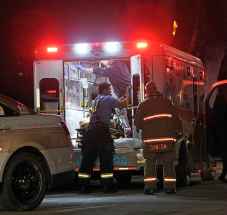For 12,000 health-care workers, change starts this week
Read this article for free:
or
Already have an account? Log in here »
To continue reading, please subscribe:
Monthly Digital Subscription
$0 for the first 4 weeks*
- Enjoy unlimited reading on winnipegfreepress.com
- Read the E-Edition, our digital replica newspaper
- Access News Break, our award-winning app
- Play interactive puzzles
*No charge for 4 weeks then price increases to the regular rate of $19.00 plus GST every four weeks. Offer available to new and qualified returning subscribers only. Cancel any time.
Monthly Digital Subscription
$4.75/week*
- Enjoy unlimited reading on winnipegfreepress.com
- Read the E-Edition, our digital replica newspaper
- Access News Break, our award-winning app
- Play interactive puzzles
*Billed as $19 plus GST every four weeks. Cancel any time.
To continue reading, please subscribe:
Add Free Press access to your Brandon Sun subscription for only an additional
$1 for the first 4 weeks*
*Your next subscription payment will increase by $1.00 and you will be charged $16.99 plus GST for four weeks. After four weeks, your payment will increase to $23.99 plus GST every four weeks.
Read unlimited articles for free today:
or
Already have an account? Log in here »
Hey there, time traveller!
This article was published 11/02/2019 (2497 days ago), so information in it may no longer be current.
It’s one of the single biggest days of change for health care in Manitoba, although nobody using the system will likely notice a difference.
Starting Tuesday, more than 12,000 people who work within Manitoba’s health care system will begin a six-week process that will result in them changing employers. Employees of dozens of disparate offices, agencies and facilities now work for Shared Health, the province’s new, central agency for the planning and delivery of health services.

Announced in 2018 with much fanfare, Shared Health has been busy assuming administrative responsibility for a number of key health services, including Winnipeg ambulance and diagnostic imaging. However, until this week, employees responsible for these services continued to work for the same entities. That changes with the launch of the first phase of a three-phase consolidation plan.
Once complete in early April, all 12,000 employees will toil for Shared Health. For the time being, there will be no job losses, no elimination of positions and nobody will be asked to move communities. Many will, however, move offices over the next six weeks as the consolidation plan unfolds.
Dr. Brock Wright, president and CEO of Shared Health, said the consolidation will affect five distinct groups or facilities within the health care system: the Health Sciences Centre; EMS and patient transport; diagnostic imaging; digital health services; and corporate support including capital planning and legal services.
The employee relocation will involve moving between three locations – the Winnipeg Regional Health Authority Headquarters on Main Street, Shared Health’s main offices at 155 Carlton Street and the Health Sciences Centre, which will become the first-ever provincial hospital under the consolidation plan.
‘When you look at what we’re trying to do… it opens up so many opportunities to improve the system. If we can improve efficiency… we can redirect dollars to areas of greatest need’
– Dr. Brock Wright, president and CEO of Shared Health
Some of the affected employees reside in communities outside Winnipeg but Wright said none is being asked to relocate to the city as part of this phase of the consolidation.
Given that this is just the first of a three-phase consolidation of health service administration and clinical standards, few people using the system will notice any change. However, Wright said Shared Health expects to achieve significant efficiencies through this process that could, over the long haul, allow the system to do more in a more financially sustainable fashion.
Ultimately, that may involve finding ways of doing more with the same or fewer people, although those decisions are not going to be made in this phase of the reorganization, Wright said.
“When you look at what we’re trying to do … it opens up so many opportunities to improve the system,” he said. “If we can improve efficiency … we can redirect dollars to areas of greatest need.”
The Shared Health model, already in place in other provinces, is based on solid reasoning. In effect, the theory is that applying the same standards for everything from procurement to administration and actual clinical treatment will ultimately produce a more efficient system.

And it is true that currently, the health system is anything but standardized. Different hospitals in different regional health authorities have different approaches to buying supplies and equipment, staffing, and even clinical guidelines for care. In theory, there are financial savings to be had by ensuring that everyone is operating under the same guidelines, both in administration and actual health care delivery.
However, any significant change within the health care system — even one like this — can present significant political challenges.
Most people fear change, and in particular any changes to something as important as health care. The Progressive Conservative government has already learned how skittish the public can be through outcries that followed the announced reorganization of Winnipeg hospitals.
There is solid reasoning behind the decision to concentrate emergency medicine in just three facilities, down from five prior to the announced changes. Three well-provisioned and staffed ERs can be, theoretically, much more effective than five emergency departments that do not have all of the equipment or medical specialists to respond to all situations.
In fact, the study that set the table for the hospital reorganization was actually commissioned by the former NDP government. It was not completed until after the NDP were driven from office in the 2016 election, and there is no way of knowing if they would have followed through on any of the recommendations.
However, logic isn’t always enough in a public relations battle involving a bitter, sceptical opposition and a worried public.
The Tory government has been hammered over some of the announced changes, particularly the decision to close the ER at Concordia Hospital. Those protests have been led in large part by the now-opposition NDP, which sees political gains in attacking the Tories on an issue which has long been recognized as their Achilles Heel.
Former Tory Premier Gary Filmon attempted several waves of change in the health care system, not all of which were meaningful and few of which were successful. That legacy continues to serve as a millstone around the neck of Premier Brian Pallister, who served as a minister in the Filmon government.
It’s not surprising, then, that certain traditional foes like the Manitoba Nurses Union continue to push back over the hospital plan.
In essence, nurses are either unwilling or unable to make some of the moves necessary to facilitate the reorganization of hospital service delivery. This has led to nursing shortages in specific units in specific hospitals affected by the changes.
It is against this backdrop that Shared Health unleashes its first wave of consolidation which, for the most part, will be the least disruptive of the three phases of change.
dan.lett@freepress.mb.ca

Born and raised in and around Toronto, Dan Lett came to Winnipeg in 1986, less than a year out of journalism school with a lifelong dream to be a newspaper reporter.
Our newsroom depends on a growing audience of readers to power our journalism. If you are not a paid reader, please consider becoming a subscriber.
Our newsroom depends on its audience of readers to power our journalism. Thank you for your support.
History
Updated on Monday, February 11, 2019 9:01 PM CST: Minor changes.








